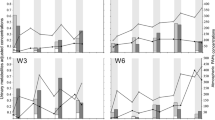Abstract
Objectives
The aim of our study was to assess individual polycyclic aromatic hydrocarbon (PAH) exposure of workers coming from three different industrial branches by several parameters of external and internal exposure. By analysing the relationships between those markers the suitability of individual parameters [e.g. monohydroxylated phenanthrene (Phe) metabolites] for exposure surveillance should be evaluated.
Methods
The total study population consisted of 255 male workers (age: 19-62, mean: 39.61 years), who were employed in coke production (n = 40), production of graphite electrodes and special carbon products (92), or production of refractory materials (123), respectively. For each worker external PAH exposure was determined by personal air sampling of 16 PAH, including Phe, pyrene (Pyr) and benzo[a]pyrene (BaP). For determination of internal PAH exposure the excretion of the PAH metabolites 1-, 2 + 9-, 3-, 4-hydroxyphenanthrene and 1-hydroxypyrene was measured in post-shift urine samples of all workers.
Results
In the total study population median total PAH exposure and exposure to BaP were 30.62 and 0.27 μg/m³, respectively. A calculation of PAH profiles resulted in substantial branch-related variations with Phe being a major component. Considering all branches the median excretions of 1-hydroxypyrene and hydroxyphenanthrenes (sum) were 6.68 and 11.22 μg/g creatinine. A correlation analysis yielded a good correlation between total ambient PAH exposure and excretion of hydroxyphenanthrenes in urine (r = 0.662; P < 0.01), but no significant correlation between Phe metabolites and the carcinogenic BaP. For 1-hydroxypyrene and BaP a weak but significant association was found (r = 0.235; P < 0.01).
Conclusions
Considering the results of the correlation analysis hydroxyphenanthrenes in urine should reflect an uptake of lowly condensed volatile PAH rather than an incorporation of highly condensed PAH like BaP which should be reflected better by 1-hydroxypyrene. Therefore, the determination of hydroxyphenanthrenes in addition to the well-established marker 1-hydroxypyrene could offer some further information about the exposure situation at a particular work place.



Similar content being viewed by others
References
Angerer J, Mannschreck C, Guendel J (1997a) Occupational exposure to polycyclic aromatic hydrocarbons in a graphite-electrode producing plant: biological monitoring of 1-hydroxypyrene and monohydroxylated metabolites of phenanthrene. Int Arch Occup Environ Health 69:323–331
Angerer J, Mannschreck C, Guendel J (1997b) Biological monitoring and biochemical effect monitoring of exposure to polycyclic aromatic hydrocarbons. Int Arch Occup Environ Health 70:365–377
Becker K, Schulz C, Kaus S, Seiwert M, Seifert B (2003) German Environmental Survey 1998 (GerES III): environmental pollutants in the urine of the German population. Int J Hyg Environ Health 206:15–24
Bentsen-Farmen RK, Botnen IV, Noto H, Jacob J, Ovrebo S (1999) Detection of polycyclic aromatic hydrocarbon metabolites by high-pressure liquid chromatography after purification on immunoaffinity columns in urine from occupationally exposed workers. Int Arch Occup Environ Health 72:161–168
Bouchard M, Viau C (1999) Urinary 1-hydroxypyrene as a biomarker of exposure to polycyclic aromatic hydrocarbons: biological monitoring strategies and methodology for determining biological exposure for various work environments. Biomarkers 4:159–187
DFG (2002) Deutsche Forschungsgemeinschaft, Angerer J. (Hrsg.): Biological monitoring. Prospects in occupational and environmental medicine. Wiley, Weinheim
DFG (2003) Deutsche Forschungsgemeinschaft, commission for the investigation of health hazards of chemical compounds in the work area (eds): list of MAK and BAT values. Report 39. Wiley, Weinheim
DFG (2004) Deutsche Forschungsgemeinschaft, Senatskommission zur Prüfung gesundheitsschädlicher Arbeitsstoffe (Hrsg.): Polycyclische aromatische Kohlenwasserstoffe (PAH). Wiley, Weinheim
Goen T, Gundel J, Schaller KH, Angerer J (1995) The elimination of 1-hydroxypyrene in the urine of the general population and workers with different occupational exposures to PAH. Sci Total Environ 163:195–201
Grimmer G, Dettbarn G, Jacob J (1993) Biomonitoring of polycyclic aromatic hydrocarbons in highly exposed coke plant workers by measurement of urinary phenanthrene and pyrene metabolites (phenols and dihydrodiols). Int Arch Occup Environ Health 65:189–199
Guendel J, Mannschreck C, Buttner K, Ewers U, Angerer J (1996) Urinary levels of 1-hydroxypyrene, 1-, 2-, 3-, and 4-hydroxyphenanthrene in females living in an industrial area of Germany. Arch Environ Contam Toxicol 31:585–590
Guendel J, Schaller KH, Angerer J (2000) Occupational exposure to polycyclic aromatic hydrocarbons in a fireproof stone producing plant: biological monitoring of 1-hydroxypyrene, 1-, 2-, 3- and 4-hydroxyphenanthrene, 3-hydroxybenz(a)anthracene and 3-hydroxybenzo(a)pyrene. Int Arch Occup Environ Health 73:270–274
Heudorf U, Angerer J (2001a) Internal exposure to PAHs of children and adults living in homes with parquet flooring containing high levels of PAHs in the parquet glue. Int Arch Occup Environ Health 74:91–101
Heudorf U, Angerer J (2001b) Urinary monohydroxylated phenanthrenes and hydroxypyrene–the effects of smoking habits and changes induced by smoking on monooxygenase-mediated metabolism. Int Arch Occup Environ Health 74:177–183
IARC (1983) International Agency for Research on Cancer: monographs on the evaluation of carcinogenic risks to humans: polynuclear aromatic compunds. Part 1: chemical, environmental and experimental data, vol 32. IARC, Lyon
IARC (1984) International Agency for Research on Cancer: monographs on the evaluation of carcinogenic risks to humans: polynuclear aromatic compunds. Part 3: industrial exposures in aluminium production, coal gasification, coke production, and iron and steel founding, vol 34. IARC, Lyon
IARC (1985) International Agency for Research on Cancer: monographs on the evaluation of carcinogenic risks to humans: polynuclear aromatic compunds. Part 4: bitumens, coal-tars and derived products, shale oils and soots, vol 35. IARC, Lyon
Jacob J, Grimmer G, Dettbarn G (1999) Profile of urinary phenanthrene metabolites in smokers and non-smokers. Biomarkers 4:319–327
Jongeneelen FJ, Anzion RB, Scheepers PT, Bos RP, Henderson PT, Nijenhuis EH, Veenstra SJ, Brouns RM, Winkes A (1988) 1-Hydroxypyrene in urine as a biological indicator of exposure to polycyclic aromatic hydrocarbons in several work environments. Ann Occup Hyg 32:35–43
Jongeneelen FJ, van Leeuwen FE, Oosterink S, Anzion RB, van der Loop F, Bos RP, van Veen HG (1990) Ambient and biological monitoring of cokeoven workers: determinants of the internal dose of polycyclic aromatic hydrocarbons. Br J Ind Med 47:454–461
Kuusimaki L, Peltonen Y, Mutanen P, Peltonen K, Savela K (2004) Urinary hydroxy-metabolites of naphthalene, phenanthrene and pyrene as markers of exposure to diesel exhaust. Int Arch Occup Environ Health 77:23–30
Lintelmann J, Angerer J (1999) PAH metabolites. In: Angerer J, Schaller KH (eds) Analysis of hazardous substances in biological materials, vol 6. Wiley, Weinheim, pp 163–187
Malkin R, Kiefer M, Tolos W (1996) 1-Hydroxypyrene levels in coal-handling workers at a coke oven. J Occup Environ Med 38:1141–1144
Marczynski B, Rihs HP, Rossbach B, Holzer J, Angerer J, Scherenberg M, Hoffmann G, Bruning T, Wilhelm M (2002) Analysis of 8-oxo-7,8-dihydro-2′-deoxyguanosine and DNA strand breaks in white blood cells of occupationally exposed workers: comparison with ambient monitoring, urinary metabolites and enzyme polymorphisms. Carcinogenesis 23:273–281
NIOSH (1994) Polynuclear aromatic hydrocarbons by HPLC. In: Cassinelli ME, O’Conner PE (eds) NIOSH manual of analytical methods (NMAM), 4th edn. National Institute for Occupational Safety and Health, Washington
Popp W, Vahrenholz C, Schell C, Grimmer G, Dettbarn G, Kraus R, Brauksiepe A, Schmeling B, Gutzeit T, von Bulow J, Norpoth K (1997) DNA single strand breakage, DNA adducts, and sister chromatid exchange in lymphocytes and phenanthrene and pyrene metabolites in urine of coke oven workers. Occup Environ Med 54:176–183
Scherer G, Meger-Kossien I, Angerer J, Knecht U (2001) Cotinine. In: Angerer J, Schaller KH (eds) Analysis of hazardous substances in biological materials, vol 7. Wiley, Weinheim, pp 171–189
Seidel A, Dahmann D, Krekeler H, Jacob J (2002) Biomonitoring of polycyclic aromatic compounds in the urine of mining workers occupationally exposed to diesel exhaust. Int J Hyg Environ Health 204:333–338
Serdar B, Waidyanatha S, Zheng Y, Rappaport SM (2003) Simultaneous determination of urinary 1- and 2-naphthols, 3- and 9- phenanthrols, and 1-pyrenol in coke oven workers. Biomarkers 8:93–109
Strunk P, Ortlepp K, Heinz H, Rossbach B, Angerer J (2002) Ambient and biological monitoring of coke plant workers—determination of exposure to polycyclic aromatic hydrocarbons. Int Arch Occup Environ Health 75:354–358
Taussky HH (1954) A microcolorimetric determination of creatine in urine by the Jaffe reaction. J Biol Chem 208:853–861
Vaananen V, Hameila M, Kontsas H, Peltonen K, Heikkila P (2003) Air concentrations and urinary metabolites of polycyclic aromatic hydrocarbons among paving and remixing workers. J Environ Monit 5:739–746
Van Rooij JG, Bodelier-Bade MM, Jongeneelen FJ (1993a) Estimation of individual dermal and respiratory uptake of polycyclic aromatic hydrocarbons in 12 coke oven workers. Br J Ind Med 50:623–632
Van Rooij JG, Van Lieshout EM, Bodelier-Bade MM, Jongeneelen FJ (1993b) Effect of the reduction of skin contamination on the internal dose of creosote workers exposed to polycyclic aromatic hydrocarbons. Scand J Work Environ Health 19:200–207
Van Schooten FJ, Jongeneelen FJ, Hillebrand MJ, van Leeuwen FE, de Looff AJ, Dijkmans AP, van Rooij JG, den Engelse L, Kriek E (1995) Polycyclic aromatic hydrocarbon-DNA adducts in white blood cell DNA and 1-hydroxypyrene in the urine from aluminium workers: relation with job category and synergistic effect of smoking. Cancer Epidemiol Biomarkers Prev 4:69–77
WHO (1998) International Programme on Chemical Safety, Environmental Health Criteria: selected non-heterocyclic polycyclic aromatic hydrocarbons, vol 202 WHO, Genf
Acknowledgements
We gratefully thank the German Hauptverband der gewerblichen Berufsgenossenschaften (HVBG), Sankt Augustin, Germany for financial and scientific support of the German PAH study and all the involved persons from companies and Berufsgenossenschaften for their excellent cooperation.
Author information
Authors and Affiliations
Corresponding author
Rights and permissions
About this article
Cite this article
Rossbach, B., Preuss, R., Letzel, S. et al. Biological monitoring of occupational exposure to polycyclic aromatic hydrocarbons (PAH) by determination of monohydroxylated metabolites of phenanthrene and pyrene in urine. Int Arch Occup Environ Health 81, 221–229 (2007). https://doi.org/10.1007/s00420-007-0209-9
Received:
Accepted:
Published:
Issue Date:
DOI: https://doi.org/10.1007/s00420-007-0209-9




